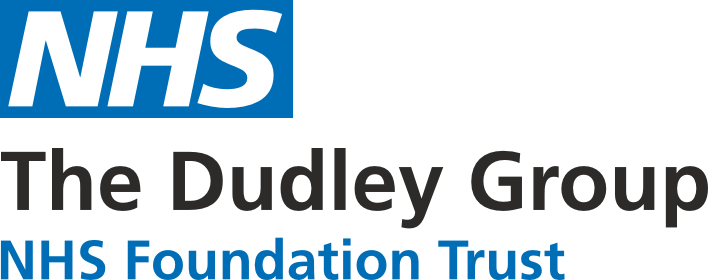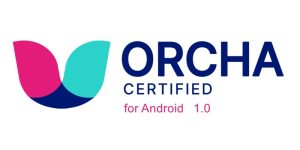Background to emergency laparotomy care and the need for a data driven tool to support training, professional development and quality improvement.
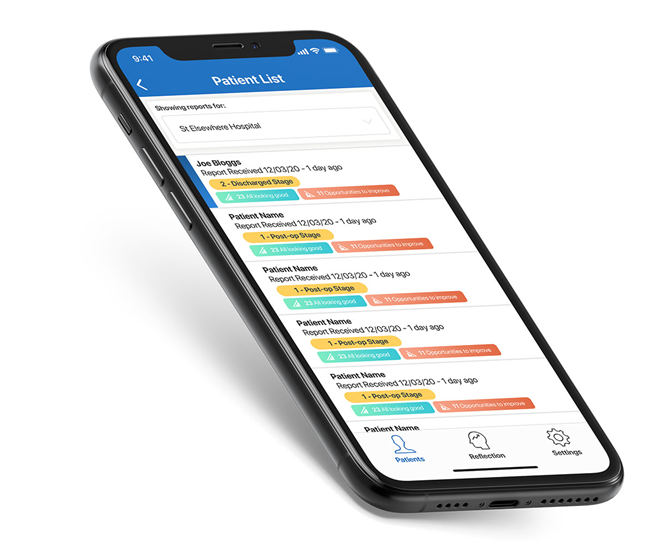 Patients with time-critical, life-threatening abdominal pathology will sometimes require urgent major abdominal surgery (emergency laparotomy), to correct the underlying problem. Identifying who needs such surgery and if so, how urgently, requires the efficient coordination of both complex elements of care and senior decision making. Despite the serious and complex nature of these illnesses, many patients receive the prompt source control surgery and multi-disciplinary care required to make a good recovery. However, delivering such care consistently to every patient (24/7 and seven days a week) remains a challenge across the NHS.
Patients with time-critical, life-threatening abdominal pathology will sometimes require urgent major abdominal surgery (emergency laparotomy), to correct the underlying problem. Identifying who needs such surgery and if so, how urgently, requires the efficient coordination of both complex elements of care and senior decision making. Despite the serious and complex nature of these illnesses, many patients receive the prompt source control surgery and multi-disciplinary care required to make a good recovery. However, delivering such care consistently to every patient (24/7 and seven days a week) remains a challenge across the NHS.
Within acute Trusts, considerable time and resource is directed at investigating cases via root cause analysis (RCA) when omissions or delays in care are considered to have occurred. But could and should we do more to maximise the learning and training opportunities that arise from the many examples of good care?
Feedback and reflection are fundamental components of training, professional development and quality improvement. But to be effective, the feedback and reflection must happen shortly after an episode of care, consider the full patient journey, and use the patient records as the basis for understanding and dialogue (https://www.iscp.ac.uk/curriculum/surgical/assessment_cbd.aspx). However, the very nature of emergency work, combined with the ‘dynamic’ make-up of on-call teams, and the frequent need to hand-over care during a single patient journey, means staff may not have a complete picture of the events before and/or after their involvement. Further, the fragmented nature of clinical records makes it challenging to piece together a full timeline of care.
QI Notify-EmLap is a data driven digital tool designed to support organisations to share secure case by case feedback in a way which is convenient to staff, supports learning, training, professional development and facilitates personal reflection.
QI Notify-EmLap 
At its core, QI Notify-EmLap transforms data, (which has already been collected as part of the NELA data set -National Emergency Laparotomy Audit-) to produce a qualitative ‘mini case-note’ review, including:
- A scrollable ‘timeline’ of a patient’s door to theatre’ journey.
- An assessment of where acknowledged standards of care were met.
- Ability to refresh knowledge regarding the appropriate standards of care.
- Functionality which facilitates personal reflective writing and/or service improvement ideas.
Approved staff are able to securely view a QI Notify-EmLap case record at a time convenient to them, helping them understand the patient journey and reflect on their role in delivering it.
QI Notify-EmLap at The Dudley Group NHS Foundation Trust
QI Notify-EmLap has been designed, piloted and implemented at The Dudley Group NHS Foundation Trust who own the product. The solution has been developed in partnership with the West Midlands Academic Health Science Network (WMAHSN) and software developer ExplodingPhone Ltd.
ORCHA (The Organisation for the Review of Care and Health Apps) are the world’s number one technology provider for delivering safe digital health. The Dudley Group have worked with ORCHA since late 2021 to ensure QI Notify-EmLap meets the regulatory requirements associated with digital healthcare apps. In the latest review (March 2023) all elements passed and we are pleased to say that QI Notify-EmLap is now a fully ORCHA certified solution.
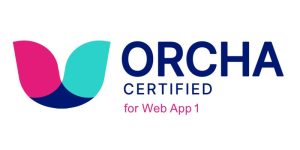
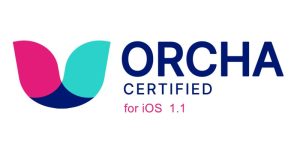
QI Notify-EmLap as a tool to support feedback, audit and training along the emergency laparotomy pathway
Background to current reporting.
NELA produce at least four different types of information/reports to support local teams to understand and improve their emergency laparotomy pathway.
- Firstly, NELA produce a detailed annual report which is a value resource to understand ‘hospital-site’ or ‘unit’ performance and identify broad areas where improvement efforts may be focused. However, by their very nature, analysis cannot begin until cases within the period of the report have been locked. Sites are given two to three months following the end of the cycle to lock records. NELA must then clean the data, link it with mortality data from ONS, perform analysis and notify sites and follow policy where they are identified as a ‘potential mortality outlier’. As such, these annual reports are typically published about one year after the end of the data collection period (or two years after the start). They report only summative data.
- NELA also produce quarterly reports, which are again a valuable resource and typically become available three to six months after the reporting period ended, again present summative data.
- Thirdly, NELA have an active website which updates as data is entered and includes valuable reporting such as the EWMA mortality chart, sepsis reports and general quality markers. However, these are only available to members of the local team with a NELA login.
- Finally, local NELA leads (again via a login) can download their NELA patient data for use in local audit and QI. Data analysis of this data can be done at any level, but typically is used for retrospective summative audits, looking for impact of QI initiatives. It requires significant resource in terms of time, expertise and interpretation.
Limitations of current NELA reporting
In addition to the timeliness of feedback described above, current reporting is often limited by who gets to receive it and whether it is provided at the individual patient level. Many staff across hospital departments have responsibilities for elements of the emergency laparotomy pathway, including ED physicians and radiologists. These staff rarely if ever receive feedback about whether a patient they helped manage subsequently required an emergency laparotomy, let alone what the findings or outcomes were. Indeed, no staff group, including surgeons and anaesthetists, routinely receive individual patient level data, and yet this is recognised as an essential component of high-quality audit and feedback.
Best practice for audit and feedback
High quality feedback, which stimulates learning, behaviour change, and improvement has many facets, and these are well understood1. If we consider the 15 attributes of ‘ideal feedback’ identified by Brehaut’s and colleagues1, we can see only five of them are reliably addressed by traditional audit cycles.
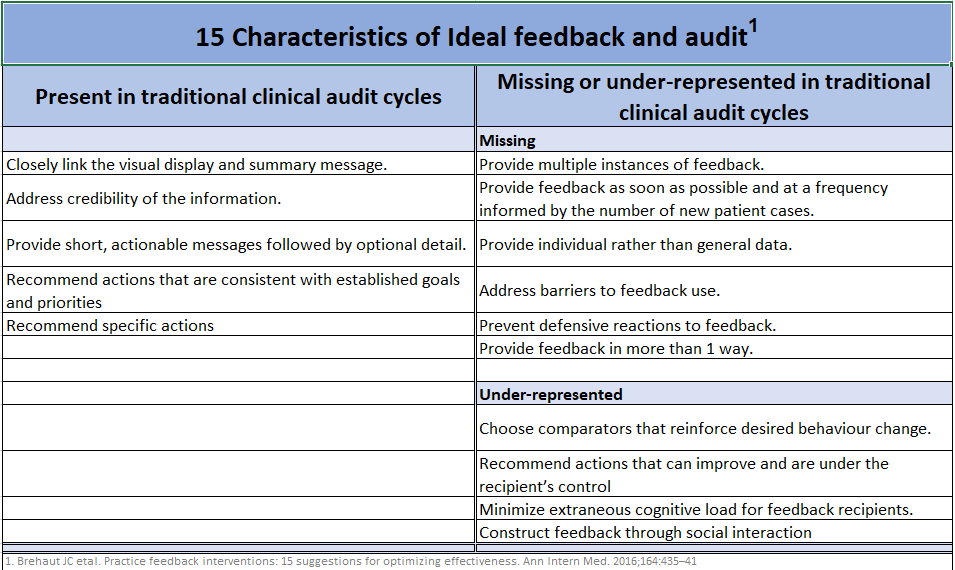
QI Notify-EmLap as a digital tool to support best practice in feedback and audit
By utilising NELA data shortly after entry, and transforming it into a ‘mini qualitative case-note review’, QI Notify-EmLap addresses many of these shortcomings by providing:
- Multiple instances of feedback, at the individual patient level, soon after care was delivered and at a frequency determined by the number of new cases.
- Distributes feedback to staff working across the emergency laparotomy pathway.
- Is viewable at a time determined by the member of staff and in a way which is easy for them to understand the positive impact their contribution made to patient care. Similarly, if they feel there was an element of care they could have delivered better, private reflection allows them to consider how they might adapt (positive behaviour change), to ensure care is delivered more reliably in the future.
- Without this individual patient level data, when we see within a traditional audit with >80% of patients receiving a high standard of care, we readily convince ourselves the occasions when the standard was missed represent ‘someone else’s practice’. However, when data is presented at the individual patient level, we understand its possible for anyone and everyone (including ourselves) to miss a standard and so change in a positive way to address this.
- Functionality to record reflective writings close to the time care was delivered.
QI Notify-EmLap as a digital tool to enhance training
Emergency surgical pathways offer important opportunities for training, not only within Emergency General Surgery but also Emergency Medicine, Radiology, Anaesthetics, Critical Care and Elderly Care. However, the nature of emergency work and on-call rotas can mean these training opportunities may not be fully realised, or on occasion missed entirely. Reflection and formative assessment, including case-based discussions (CBDs) are a core element of training and should occur shortly after care was delivered, include the full patient journey and be based on the clinical record. The fragmented and complicated nature of hospital records can make accessing these in a way which readily supports CBDs involving the emergency laparotomy pathway challenging.
Therefore, QI Notify-EmLap, by providing:
- A timeline of care from ‘door to theatre’ (and later discharge),
- A qualitative assessment of care delivered along a patients journey and
- Functionality to allow the capture of private reflective writings
facilitates and maximises the opportunities for CBD and formative assessments within this challenging training environment.
Here you can find further information relating to the following:
- Real world evaluations – this page provides evaluations from QI Notify-EmLap users and contains one undertaken by Mr Peter Waterland, consultant colorectal surgeon at Dudley Group NHS Foundation Trust
- Case studies – please click on the logos below to view recent case studies relating to QI Notify-Emlap or via:
- Case study 1 – West Midlands Academic Health Science Network
- Case study 2 – ExplodingPhone
- If you are interested in finding out more about QI Notify-Emlap in your organisation or Trust, please follow this link to our expression of interest form.
- QI-Notify-EmLap privacy notice – explaining how QI Notify-EmLap manages personal data.
- QI Notify terms of use – please note this page is currently under development.
